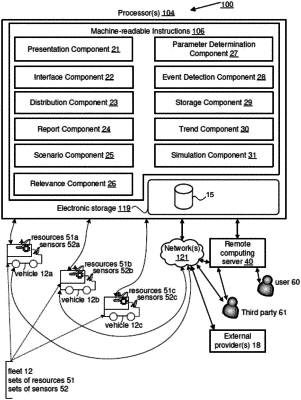| CPC G07C 5/008 (2013.01) [G06F 16/2462 (2019.01); G06F 16/29 (2019.01); G06F 16/9537 (2019.01); G06F 30/20 (2020.01); G07C 5/02 (2013.01); G07C 5/085 (2013.01)] | 15 Claims |

|
1. A system configured to generate vehicle event information, the system configured to couple with a fleet of vehicles including a first vehicle, the system comprising:
a remote computing server including one or ore processors configured via machine-readable instructions to:
control access to a stored set of vehicle event scenarios that are associated with vehicle events, wherein individual vehicle event scenarios represent circumstances around a particular vehicle for at least a first predefined period prior to occurrences of potential vehicle events, wherein the potential vehicle events have particular event types, and wherein individual vehicle event scenarios include individual geographical locations;
receive, from the first vehicle, information related to a detected vehicle event, wherein the detected vehicle event is associated with a particular geographical location, and wherein the detected vehicle event has a particular event type;
compare the particular event type and the particular geographical location of the detected event with corresponding information for the stored set of vehicle event scenarios; and
based on the comparison, determine whether to add a new vehicle event scenario to a set of new vehicle event scenarios that are not included in the stored set of vehicle event scenarios, wherein the new vehicle event scenario is based on the received information, and wherein the set of new vehicle event scenarios represents circumstances around particular vehicles that are related to vehicle events.
|